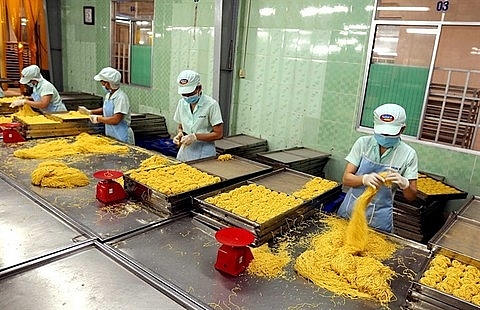Ministries to study US tax reform
 |
| Workers at Safoco Foodstuff JSC process instant noodles. - VNA/VNS Photo Vu Sinh |
The ministries of Finance and Planning and Investment will complete the report and send it to the Prime Minister before March 1 this year.
Phuc also assigned the Ministry of Industry and Trade to co-ordinate with relevant ministries and sectors to monitor policy responses of countries around the world as the United States implements the new tax reform law, assessing the impacts on Viet Nam to help it respond appropriately and in a timely manner.
"It is necessary to review the products Viet Nam exported to the US, especially the products with the content of raw materials and components imported from China in order to give warnings and guide enterprises when the US imposes anti-dumping duties on these products," said the PM.
According to the PM’s economic advisory group, the US new tax reform package cut top corporate income rates to 21 per cent from 35 per cent. At the same time, it will tax foreign investment receipts transferred back to the country at the rate of 10.5 per cent. With this tariff, the US has become the world’s lowest taxing country.
The advisory group of the Prime Minister said that the US tax policy in the immediate time may not affect Viet Nam much, but in the long term it will impact the country, reported the online newspaper dantri.com.vn.
"As other economies apply defensive measures such as adjusting exchange rate policies, foreign exchange controls will affect foreign investment flows, thereby affecting Viet Nam, especially the exchange rate," said the Advisory Group.
US President Donald Trump signed the tax reform package on December 22 last year. Analysts say this measure will improve corporate profits, boosting the economy.
Under the new tax law, up to 95 per cent of Americans will receive tax breaks, but cuts to the rich will outweigh the tax cuts for lower income people. According to the Non-partisan Tax Policy Centre in Washington, it is estimated that households will receive an average tax cut of about US$900 next year, but the top 1 per cent will get a break of $51,000 on average.
What the stars mean:
★ Poor ★ ★ Promising ★★★ Good ★★★★ Very good ★★★★★ Exceptional
 Tag:
Tag:
Related Contents
Latest News
More News
- Double-digit GDP growth within reach with shift to higher-value expansion (January 06, 2026 | 08:33)
- Ho Chi Minh City projects $10.5 billion remittance inflows in 2025 (December 31, 2025 | 18:58)
- Digital shift reshaping Vietnam’s real estate brokerages (December 31, 2025 | 18:54)
- New decree sharpens enforcement in securities market (December 31, 2025 | 18:53)
- Voluntary Sustainability Standards pave way for Vietnam’s agricultural exports (December 31, 2025 | 09:00)
- Gold market reform advances as SBV receives applications for bullion production (December 30, 2025 | 12:07)
- Textile apparel firms deliver robust earnings despite global tariff pressures (December 30, 2025 | 10:09)
- Ho Chi Minh City hits $8.37 billion in FDI (December 29, 2025 | 08:28)
- Tax sector wraps up 2025 and sets priorities for next year (December 25, 2025 | 14:00)
- Heavy industries set for pilot greenhouse gas quotas (December 25, 2025 | 10:00)






















 Mobile Version
Mobile Version